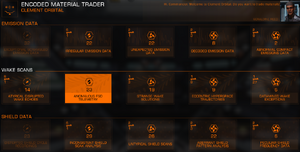
Material Trader (Encoded)
The Material Trader is a contact found at certain stations that offers to exchange one Material for a different quantity of another Material. There are three types of Material Trader, each dealing exclusively in one type of Materials: Raw Materials, Manufactured Materials, or Encoded Materials.
Location factors[]
Each Material Trader type only trades in their specific type of Materials. A station's economy type determines which Material Trader may be present:
- Raw Materials Trader: Operate in Refinery and Extraction economies, only trade in Raw Materials;
- Manufactured Materials Trader: Operate in Extraction and Industrial economies, only trade in Manufactured Materials;
- Encoded Materials Trader: Operate in High Tech and Military economies, only trade in Encoded Materials.
Other variables can also restrict the presence of Material Traders:
- Material Traders are generally only found in systems with medium or high security, and with populations between 1,000,000 and 22,000,000.
- Materials Traders are unavailable in systems controlled by an anarchy minor faction.
- Materials Traders are unavailable at stations that are currently damaged, repairing, under lockdown, or controlled by an anarchy minor faction.
Exchange tables[]
Depending on the grade and category of a Material, the amount of other Materials that can be traded for one unit of it varies. The interface that Material Traders use to present this information and conduct trades is a table. Materials of the same grade are displayed in the same vertical column, while Materials of the same category are displayed in the same horizontal row. These exchange tables are reproduced below.
Raw Materials Trader[]
| Section | Grade 1 | Grade 2 | Grade 3 | Grade 4 |
| Raw Material Category 1 | Carbon | Vanadium | Niobium | Yttrium |
| Raw Material Category 2 | Phosphorus | Chromium | Molybdenum | Technetium |
| Raw Material Category 3 | Sulphur | Manganese | Cadmium | Ruthenium |
| Raw Material Category 4 | Iron | Zinc | Tin | Selenium |
| Raw Material Category 5 | Nickel | Germanium | Tungsten | Tellurium |
| Raw Material Category 6 | Rhenium | Arsenic | Mercury | Polonium |
| Raw Material Category 7 | Lead | Zirconium | Boron | Antimony |
Manufactured Materials Trader[]
Encoded Materials Trader[]
Exchange rates[]
The exchange rate of a Material depends on its position in the above exchange tables. In summary:
- Trading for a Material that is one grade lower gives a 3:1 return.
- Trading for a Material that is one grade higher gives a 1:6 return.
- Trading one category for another gives a 1:6 return.
- Changing both grade and category, and/or changing by more than one grade, multiplies all the relevant factors together.
Materials in the same category[]
This table lists the exchange rates used when converting between items of the same category.
Example: trading Open Symmetric Keys (Grade 3 Encryption Files) for Adaptive Encryptors Capture (Grade 5 Encryption Files), 36 units of input data are consumed to yield 1 unit of output data.
| Input Grade | ||||||
|---|---|---|---|---|---|---|
| 1 | 2 | 3 | 4 | 5 | ||
| Output Grade | 1 | - | 1 → 3 | 1 → 9 | 1 → 27 | 1 → 81 |
| 2 | 6 → 1 | - | 1 → 3 | 1 → 9 | 1 → 27 | |
| 3 | 36 → 1 | 6 → 1 | - | 1 → 3 | 1 → 9 | |
| 4 | 216 → 1 | 36 → 1 | 6 → 1 | - | 1 → 3 | |
| 5 | 1296 → 1* | 216 → 1 | 36 → 1 | 6 → 1 | - | |
Materials in different categories[]
This table lists the exchange rates used when converting between items of a different category. Converting between different categories of material is more expensive.
Example 1: trading Adaptive Encryptors Capture (Grade 5 Encryption Files) for Peculiar Shield Frequency Data (Grade 5 Shield Data), 6 units of input data are consumed to yield 1 unit of output data.
Example 2: trading Open Symmetric Keys (Grade 3 Encryption Files) for Datamined Wake Exceptions (Grade 5 Wake Data), 216 units of input data are consumed to yield 1 unit of output data.
| Input Grade | ||||||
|---|---|---|---|---|---|---|
| 1 | 2 | 3 | 4 | 5 | ||
| Output Grade | 1 | 6 → 1 | 2 → 1 | 2 → 3 | 2 → 9 | 2 → 27 |
| 2 | 36 → 1 | 6 → 1 | 2 → 1 | 2 → 3 | 2 → 9 | |
| 3 | 216 → 1 | 36 → 1 | 6 → 1 | 2 → 1 | 2 → 3 | |
| 4 | 1296 → 1 * | 216 → 1 | 36 → 1 | 6 → 1 | 2 → 1 | |
| 5 | 7776 → 1 * | 1296 → 1 * | 216 → 1 * | 36 → 1 | 6 → 1 | |
Note that the conversions marked with an asterisk (*) in the table above are not possible to achieve due to the limitations on material/data storage.
Notes[]
- Material Traders were added with Elite Dangerous: Beyond Chapter One (3.0) on February 27, 2018. Their services are only available to owners of Elite Dangerous: Horizons.


